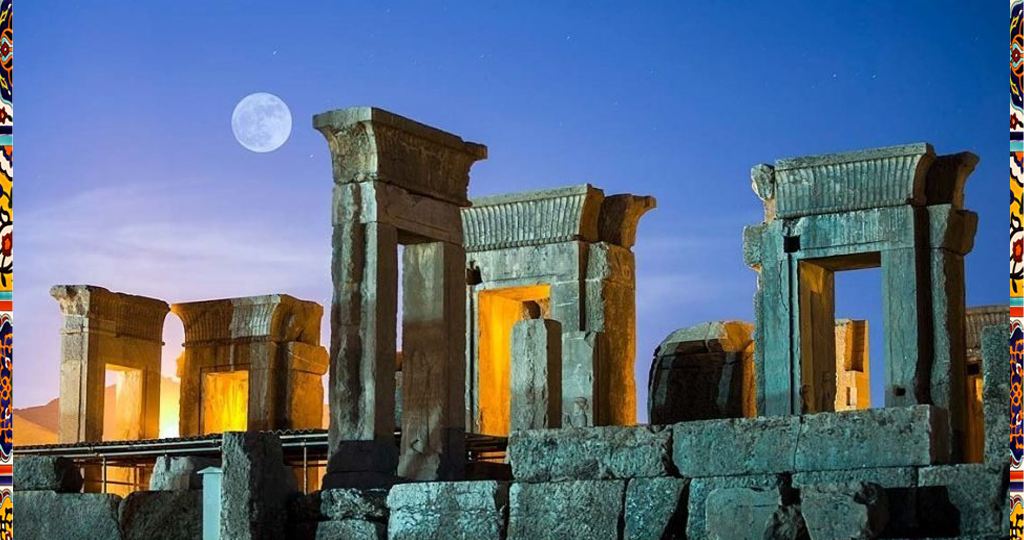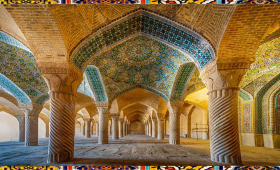Persepolis is a palace for peace, the place that you can just see it and imagine its glory and architecture. The place for all of the people from the whole world that you can see all of the symbols from the whole countries before B.C.
Conception and Location
Persepolis is located in the Marvdasht Plain 50 km northeast of Shiraz. This palace presents what may be the most awesome ruins of the ancient world. This palace is located on a promontory projecting into the plain from a rocky hill at the foot of the northwest corner of the mountain of Mercy, a holy mountain at that time. According to the testimony of Achaemenid documents, the original name of the new Achaemenid capital was Parseh. This was also the name of the nearby settlement and of the people inhabiting it. The name Persepolis is a Greek word for the “City of the Persians”, and this is the appellation widely known and accepted in the West. However, in Iran the site is known as Takht-e Jamshid (“the Throne of Jamshid”), after king Jamshid, whose behests were carried out by demons. The name possibly derived from the popular belief in the supernatural origin of the structures. Thus, one of the medieval geographers confessed: “If it be said that a jinn or fairy had made this city, this would be acceptable to the intellect”.
Construction and Function
By the time, Darius the Great undertook here the construction of Persepolis in around 518 B.C. Persepolis palace was one of the Achaemenid capitals that was for official ceremonies associated with the greatest national, royal, and religious festival of the Iranians Nowruz. A symbol of the empire’s sovereignty over its far-flung dominions. Persepolis was conceived as magnificent showcase of Achaemenid achievements, a fabulous repository of the most spectacular architectural and artistic achievements anywhere in the ancient world. With the power and wealth which had been accumulated in the country by this time, it should not surprise us that these ambitious goals were fully achieved. Persepolis was a great center of terrestrial power, providing an effective setting for invocation and worship. The city glorified the divinely-sanctioned dynasty, and was imbued with the peculiar virtue of royal authority believed to be conferred by the power of Ahuramazda, located at the very birthplace of the empire. Persepolis was its holy center, as are Mecca, Jerusalem, and the Vatican of their respective religious system today. It is most probable that the king’s family and retinue and perhaps the king himself resided in a settlement occupying a vast plot of land around the platform, and the king might have attended his palaces only on special occasions.
Architecture and Art
The architecture and art of Persepolis reveals an eclectic synthesis of forms gathered from all parts the Achamenid realm. However, it is astonishing that the resulting blend of so many styles and influences was original and coherent despite its eclecticism. From the intermingling of ideas and fashions, and under the supervision and planning of Persian masters, there emerged the so-called Achaemenid style, highly cosmopolitan and multifarious on the one hand, and harmonious and concordant on the other. Mud-bricks supplied by Babylonians, cedar roof beams from Lebanon, precious materials from India and Egypt, gold from Sardis, and stone quarried nearby but carved by Lydians and Ionians, all united in a single passionate endeavor to create the magnificent complex of structures that was Persepolis.
Conclusion of Achaemenid
The construction of Persepolis encompassed a very long period, which included the reigns of Darius the Great and his successors. The city flourished for about two centuries until in 330 B.C., it was plundered burnt and left in ruins by Alexander the Great. Although the buildings were set on fire during a drunken orgy, this was not an accident. More over conflagration carried a very clear message: if left intact, the city would have lingered as dangerous reminder of Persian power in a region only recently subdued. Persepolis was never rebuilt, and soon after the fall of the Achaemenid, its history was forgotten. Buried under mounds of rubble and ashes, its few columns managed to attract the attention of travelers as far back as the 15th century. Real excavating however, began only in the early 1930s, and has continued on and off since then.
Nowadays many Iranian and foreign tourists come to Shiraz and visit this glory palace. So Persepolis is one of Persian’s honor that we do our best to introduce it well and protect it.
References:
[1] A. Bihishti, Travel Guide to Fars, Iran _ Lessie Weatherman _ 9789643342456. Tehran, Iran: Rowzaneh, 2006.
[2] H. Koch, Es kündet Dareios der König…: Vom Leben im persischen Grossreich, no. 55. Tehran, Iran: karang, 1992.



